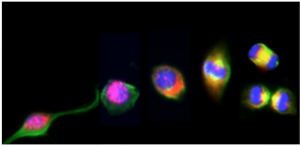By Cristy Lytal
How do humans and other mammals get so brainy? USC researcher Wange Lu, PhD, and his colleagues shed new light on this question in a paper published in Cell Reports on Oct. 24.
The researchers donned their thinking caps to explain how neural stem and progenitor cells differentiate into neurons and related cells called glia. Neurons transmit information through electrical and chemical signals; glia surround, support and protect neurons in the brain and throughout the nervous system. Glia do everything from holding neurons in place to supplying them with nutrients and oxygen, to protecting them from pathogens.
By studying early mouse embryo neural stem cells in a petri dish, Lu and his colleagues discovered that a protein called SMEK1 promotes the differentiation of neural stem and progenitor cells. At the same time, SMEK1 keeps these cells in check by suppressing their uncontrolled proliferation.

In the neural stem cells at left, the protein SMEK1 (red) is localized in the nucleus (blue), while the protein PAR3 (green) is in the cytoplasm. When neural stem cells divide, as in the cells at right, SMEK1 moves to the cytoplasm, where it regulates PAR’s activity.
(Photo/Courtesy Wange Lu)
The researchers also determined that SMEK1 doesn’t act alone; it works in concert with Protein Phosphatase 4 to suppress the activity of a third protein called PAR3 that discourages neurogenesis, or the birth of new neurons. With PAR3 out of the picture, neural stem cells and progenitors are free to differentiate into new neurons and glia.
“These studies reveal the mechanisms of how the brain keeps the balance of stem cells and neurons when the brain is formed,” said Lu, associate professor of biochemistry and molecular biology at Keck School of Medicine of USC, and part of the Eli and Edythe Broad Center for Regenerative Medicine and Stem Cell Research at USC. “If this process goes wrong, it leads to cancer, or mental retardation or other neurological diseases.”
Neural stem and progenitor cells offer tremendous promise as a future treatment for neurodegenerative disorders, and understanding their differentiation is the first step towards harnessing this therapeutic potential. This could offer new hope for patients with Alzheimer’s, Parkinson’s and many other currently incurable diseases.
Co-authors from the Eli and Edythe Broad Center for Regenerative Medicine and Stem Cell Research at USC include: Vicky Yamamoto, PhD; Si Ho Choi, PhD; and Zhong Wei, PhD. Co-authors Hee-Ryang Kim and Choun-Ki Joo, PhD, are from the Catholic University of Korea in Seoul, and first author Jungmook Lyu, PhD, is affiliated with both institutions.
Funding for this study came from National Institutes of Health grant 5R01NS067213.

